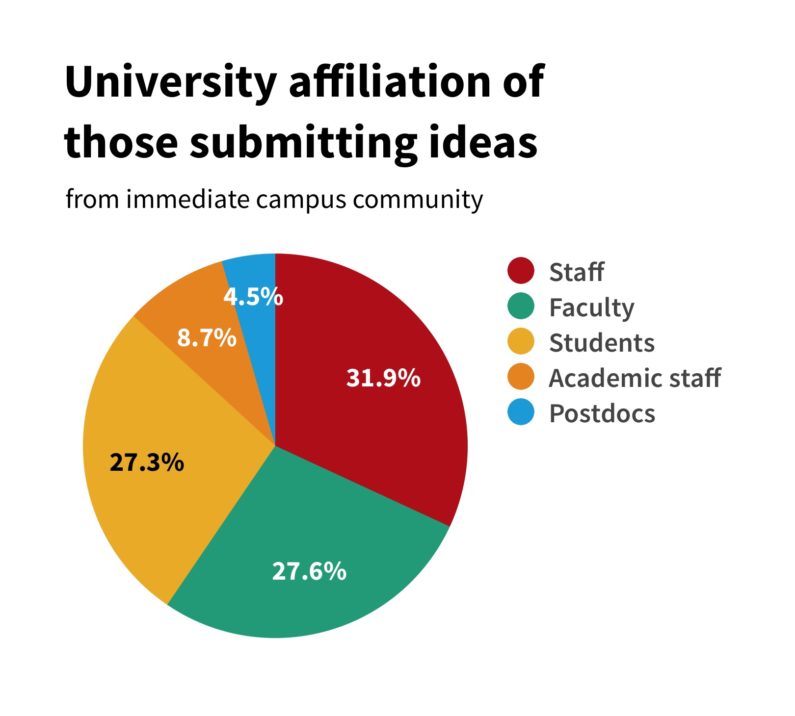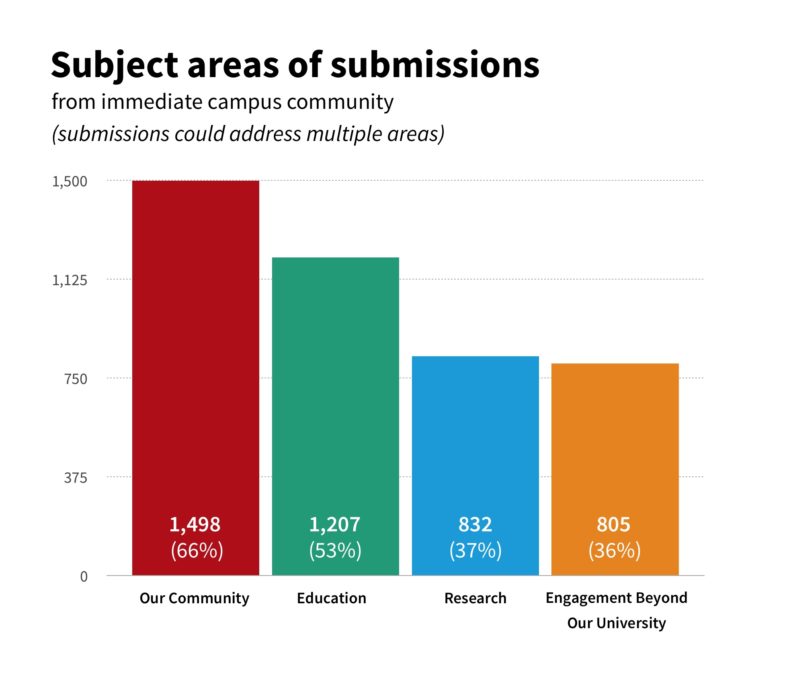2,765 ideas for Stanford’s future
Students, faculty, staff and alumni responded to the call for ideas and proposals to inform Stanford's long-range planning process. Four area steering groups will now begin digging into the task of reviewing and contextualizing the submissions.
Stanford students, faculty, staff and alumni submitted 2,765 proposals for consideration in the university’s long-range planning process, responding to the call for a wide array of ideas to help shape a vision for the university’s future.
The deadline to submit ideas was July 1. Of the total, 2,263 submissions came from the immediate campus community and another 502 came from Stanford alumni around the world.
President Marc Tessier-Lavigne and Provost Persis Drell, who are co-leading the long-range planning process, said they were delighted by the outpouring of ideas and by the community outreach that led to them.
“We are gratified by how enthusiastically and thoughtfully the Stanford community has contributed ideas to this process,” Tessier-Lavigne said. “We wanted broad thinking from every part of the university community, and the community responded. The time and energy that people put into their submissions, both individually and in groups, is a wonderful statement of their care and concern for Stanford and its future.”
Outreach efforts by a range of campus leaders helped stimulate the submissions, which could range from a single sentence to three pages in length on any topic relevant to Stanford’s future.
“The members of the area steering groups, student leaders and many others in the campus community took the initiative to rally colleagues and friends to submit ideas and proposals,” Drell said. “We are so appreciative of everyone who worked to develop a submission or encouraged others to do so. And we’re committed to a process that gives every idea and proposal the full consideration it deserves.”
The ideas that were submitted are too numerous to summarize at this stage; some examples were posted earlier on the long-range planning website. But a few data points illustrate the breadth of participation in the effort:
- The university affiliation of those who contributed ideas from the immediate campus community was 31.9 percent staff, 27.6 percent faculty, 27.3 percent students, 8.7 percent academic staff and 4.5 percent postdoctoral scholars.
- The process sought ideas centered around four key areas, and submissions could touch on multiple areas. Overall, among the submissions from the on-campus community, 66 percent addressed the Our Community area; 53 percent addressed Education; 37 percent, Research; and 36 percent, Engagement Beyond Our University (totaling more than 100 percent because of the ability to address multiple areas).
- Among the immediate campus community, 63 percent of the ideas and proposals were submitted by individuals and 37 percent by groups.
- Perhaps demonstrating the motivational impact of a looming deadline, more than 1,300 of the ideas were submitted in the last 24 hours that entries were accepted.
In addition to the submissions from the immediate campus community, the Stanford Alumni Association encouraged ideas and proposals from alumni through a separate process, producing another 502 submissions from alumni that will be evaluated.
Among the alumni submissions, 65 percent addressed the Education area; 61 percent addressed Our Community; 57 percent, Engagement Beyond Our University; and 36 percent, Research (again totaling more than 100 percent because of the ability to address multiple areas).
What comes next? The action now moves to four area steering groups of faculty, students and staff, each led by two faculty co-chairs.
Between now and October 15, the area steering groups will be charged with reviewing the ideas and proposals, identifying links between them, organizing them conceptually, and providing perspective and analysis on them.
Tessier-Lavigne and Drell are meeting this summer with each of the area steering groups as they continue their work. Proposals ultimately will make their way to the executive cabinet of the university for further review, consideration and consultation with senior leadership. That includes both long-term strategic ideas as well as more tactical, near-term suggestions for improving specific areas of the university’s operations.
University leaders will then work to compose a long-range plan for presentation to the Faculty Senate, university community and Board of Trustees next spring.
While the area steering groups have an enormous amount of work to do in reviewing the proposals, things aren’t going entirely behind the scenes. Tessier-Lavigne and Drell expect to be talking with the campus community about emerging areas of interest as they are identified through the process. Stanford Report and other communication channels also will provide updates on the process and a window into the work of the area steering groups.


